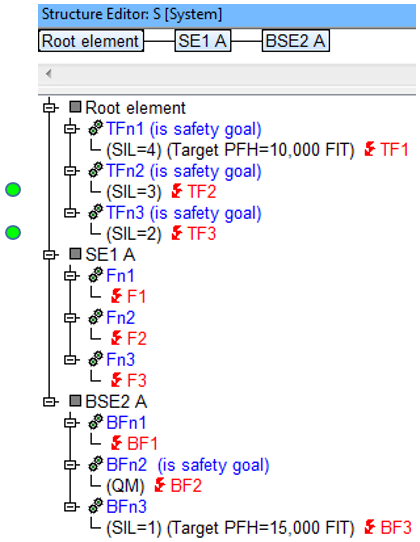Search:
DSCF without PFH-target value
Explanation:
A search will be made for dangerous safety-critical failures (DSCF), for which no PFH-target value (IEC 61508) is assigned
Note:
- A DSCF (Dangerous Safety Critical Failure) is a failure, which is anchored at a function identified as a safety goal (see properties dialog) and has a safety level (SIL/ASIL) not equal to QM (Quality Management).
- PFH (IEC 61508) = Probability of (Dangerous) Failure per Hour [FIT]
Example:
Abbreviations
- ASIL = Automotive safety integrity level
- BF = Base failure of a base function
- BFn = Base function of a base structure element
- BSE = Base structure element
- Cl Prc = Classification for process characteristic
- Cl Prd = Classification for product characteristic
- Cl Req = Classification for requirement
- CM = Control method
- DA = Detection action
- DC = Diagnostic coverage
- DSCF = Dangerous safety critical failure
- Er Det = Error detection
- Er Resp = Error response
- F = Failure
- FIT = Failure in time
- Fn = Function
- FSM = Functional safety management
- IE = Inspection equipment
- LF = Latent fault
- LFM = Latent fault metric
- OC = Operating condition
- PA = Preventive action
- PE = Process element
- PFH = Probability of failure per Hour
- PMHF = Probabilistic metric for random hardware failures
- PrcC = Process characteristic
- PrdC = Product characteristic
- QM = Quality method
- QR = Quality rule
- Req = Requirement
- RMR = Risk Matrix Ranking
- RP = Reaction plan
- SE = Structure element
- SE ErDet = Structure element for error detections
- SE ErResp = Structure element for error responses
- SFF = Safe failure fraction
- SG = Safety Goal
- SIL = Safety integrity level
- SM = Organisational-SE for “safety mechanisms”
- SPF = Single point fault
- SPFM = Single point fault metric
- TF = Top failure of a top function
- TFn = Top function at root element
- TS = Test sample

- The above structure contains three system elements, each of which has three functions which in turn each have one failure. The functions that contain safety goals have this info in brackets in the function name.
- The aim of this Quality Rule is to find failures with safety mechanisms assigned. Furthermore, these failures must have different safety levels to that of QM and also no PFH-target value assigned.
- With the Display option “Functional Safety parameters” active, it is possible to see which failures have different safety levels to that of QM and also which do and don’t have PFH-target values assigned.
Search result: ![]()
Analyzing the image above, only four failures are anchored at safety mechanisms and thus only these can be considered in the search. One of these, BF2, does not have a differing safety level to that of QM and therefore is not a hit. From the three failures left, one has a PFH-target value assigned (TF1) and therefore also is not a hit. This leaves TF2 and TF3 as hits.